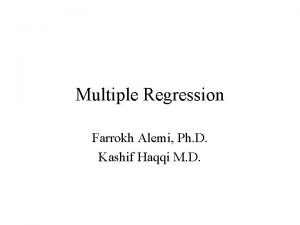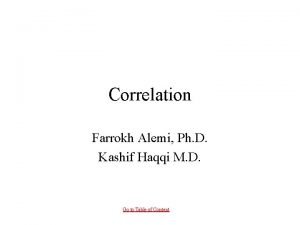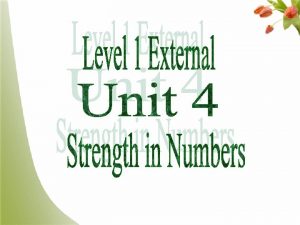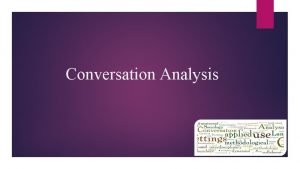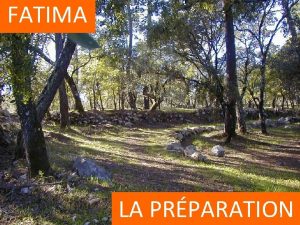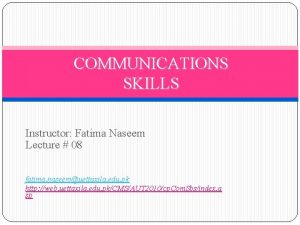Conversation Analysis Teacher Name Mahvish Fatima Kashif Conversation










- Slides: 10

Conversation Analysis Teacher Name: Mahvish Fatima Kashif

� � � Conversation: A conversation is an exchange of thoughts and ideas between two or more people. A conversation occurs when people cooperate with each other in order to introduce and sustain a single focus of attention by taking turns with each other

� It studies the methods of conversation which people use to organize a social talk. � It investigates rules and practices from an interactional perspective and studies them by examining recordings of real-life interactions.

� Although the foundational work in CA focuses on talk in conversations, the framework has gradually been extended to research of other types of talks such as medical and clinical interactions, lessons, or news interviews. This is way the more general characterization “talk in interaction” nowadays is often preferred over “conversation”.

Studying Transcriptions of Recorded Talk The recording are transcribed according to specific conventions. � Transcription Notation: It helps to retain features of prosody and turn positioning in the transcription. � The length of silences between and within turns in measured in tenth of seconds. �

A dot between brackets (. ) indicates a short silence of less than 0. 2 seconds. � In the case of simultaneous talk, the onset of the overlapping turn is located by a left square bracket in the overlapped turn. � A period indicates a falling final pitch contour, a comma a slightly rising pitch contour, and a question mark a strongly rising one. �

Organization of Conversation � 1) 2) Two levels of organization Turn taking The participants know where and how to the roles of speaker and listeners. Sequence Organization There is a coherent exchange of communicative actions for instance the episode with a question and it ends with the answer to that question.

Turn Taking Interruption and gaps are real. � The basic organizational problem that participants have to solve, each turn anew, is to determine when the speaker will complete the current turn. � The recipient is not only figuring out what the turn is about and what the speaker is doing with it, he also has to be alert for the moment it might become his turn to speak. �

Turn Constructional Units (TCUs) Each turn is built with at least one turn constructional unit such as the turns when no more than the words here, yes or no. Other TCUs have a syntactically more elaborate design, such as the interrogative clause “is she there too? ” � The construction of a TCU, the recipients will make different predictions as to when the ongoing turn.

Sequence Organization � - The ways conversationalists link turns to each other as a coherent series of interrelated communicative actions is called sequence organization. Question/Answer Request/Decision Informative/Receipt Criticism/Reply These two parts sequences are adjacency pairs.




